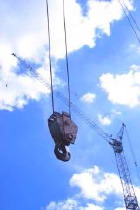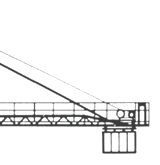In human history, there was always a drive to create buildings and monuments that endured the time of their construction by far. People did so to create permanent signatures of their origin, their belief and their activities. Examples of this are in particular the pyramids in Egypt, old temples, bridges and religious architecture, to mention a few. The observer with technical interest may ask how these cultures were able to create such demanding buildings: How did people transport ton-heavy pieces and materials to the building ? From around 2750BC on, human buildings were made by stacks of rocks and building blocks. Already then they used ropes and winches to lift and move enormous loads. Derricks and wooden beam winches were visible signs of active construction projects. Also for loading and unloading of boats such tools found much use. In those days they were driven by “biological force”: As those primitive early lifting devices had of course no modern drive mechanisms, they were operated and driven by human or animal power. Until a few centuries ago, lifting and slewing was enabled by hand winches and threadmills. The pictures here can only deliver a simple sketch of some stations in the evolution of lifting technology that leads to the modern, industrially manufactured crane we know nowadays. The crane- and construction technology museum focuses predominantly on developments that started with the invention of steam power in the time of the industrial revolution around the late 19th century.
For example, in the area of crane technology of the museum, the 15m crane by Kaiser (Brun) TK B and the Wolff F45EW demonstrate the first industrialised construction of tower cranes. Those “prototypes” hit the market in 1912 and 1913, defining a milestone on the road of crane technology that winds on to the current day !
The development of crane- and construction technology
Crane technology: A short journey through centuries
A „unique“ project of technology history and „eye catcher“
Prof. Dr. Ing. H. Ernst, a well renowned specialist in the 1950s and 1960s, wrote in one of his numerous publications about tower cranes in 1961:
”…While the devolopment of other cranes happend inside of the factories belonging to crane manufacturers and crane users, the tower crane evolution was visible in open public. The numerous post-war building sites, that were equipped with primitive lifting gear at first, got at least one tower crane – some large projects even got a whole forest of them. Hence the tower crane became a symbol for the post-war reconstruction itself. This quantitative success was only possible due to the adaptation of the crane to new demands. Low weight, hence less cost and easier transport from site to site, ease of assembly, simplicity of operation, adaptation to different on-site situations and toughness in harsh conditions were the main points that were essential for the post-war tower crane evolution. Of the numerous and partly complicated variety of shapes, within the last decade versions evolved that show their maturity by simplicity. Instead of setting up gantries followed by erecting the whole tower that had to be preassembled on the ground, today the tower is telescopic or it can be folded. Both solutions mean that road transport is simplified while the effort required for erecting the tower to the vertical is minimised. The luffing jib is increasingly replaced by solutions with horizontal load path, as the best solution for the jib is a horizontal load path what is simply realised. To adapt the crane to the progress of the project – particular important on high-rise buildings – several types of climbing cranes got developed where the hook height keeps pace with the building. There is one kind where the crane rests on the ceilings of the floors erected before, and using a climbing winch the crane pulls itself up from floor to floor. Another solution is located outside the building where additional tower sections are being added to make up the height, with these operations made by the crane itself.”
The tower crane subject in particular, with it’s way of composition of preserved “key machines”, makes the crane- and construction equipment museum unique !



20th century: „Revolutionising“ construction sites with tower cranes
At the start of the 20th century, in Germany the development of construction site cranes began especially to move bulky wooden shells, heavy slabs and for the task of casting large amounts of concrete. 1911/12, the company of Kaiser & Schlaudecker of St. Ingbert offered a bottom slewing gantry crane with a topless luffing beam jib. In 1913, the company of Julius Wolff & Co. introduced the first top-slewing tower crane with long reach and relatively high capacity at the Leipzig technology fair. The press called it a “revolution” of the construction site. Tower cranes rationalised work, as construction got quicker and involved less work force. On the same time – as a side effect – cranes had a large social and human impact: There were less humans who had to carry material over ladders and scaffolding up the buildings. One of those “odd job men” was depicted by August Sander in 1928 – on the board on his shoulder 22 bricks are stacked, each worth less than a penny but in total they amounted to nearly 90 kilograms. Considering that for a typcial multi storey block of flats in Berlin about one million bricks were necessary, this leaves an impression about how laboursome the jobs of those “slaves” was in those days. With the introduction of the tower crane, the “servants” disappeared from the construction sites, getting back their human dignity.
At first, tower cranes were rare occurances. Up to 1940 they were mostly developed by the companies of Pekazett (Peschke) in Zweibrücken, Kaiser in St. Ingbert (Saar), Hüttenwerke Sonthofen, and Wolff in Heilbronn. But the real revolution started due to the large scale of destruction that left Germany shattered after World War 2. The reconstruction demanded huge effort by the construction industry that was already in despair by lack of work force. Main driver was the acute lack of accomodation, besides of the rebuild of the industry. The former construction entepreneur Dr. Ing. h.c. Hans Liebherr was the great pioneer on post-war tower crane construction. Hence, the cranes he constructed from 1949 on are widely associated with his personality. Apart from Pekazett (Peschke), Kaiser and Wolff other companies hit the market with some delay, as the PEINER engineering company, the Kaiserslautern iron works (EWK), Wetzel, Hilgers-Vögele and Reich.
The cranes then, while small in today’s scale, only took over the task of lifting and carrying of the small and handsome loads that were typcial for construction sites of those times. However, once cranes were available, the demands on their size and capacity grew. Cranes now were adapted to the developments of modern construction. The maxime “faster, bigger, taller” forced tower cranes into growing to giants of steel.
This permanent exhibition of the history of crane- and construction site technology is aimed to keep the memory of the odd-job men of the past and to be a memorial for the efforts done in post-war Germany that lead to the economic boom in the west.


